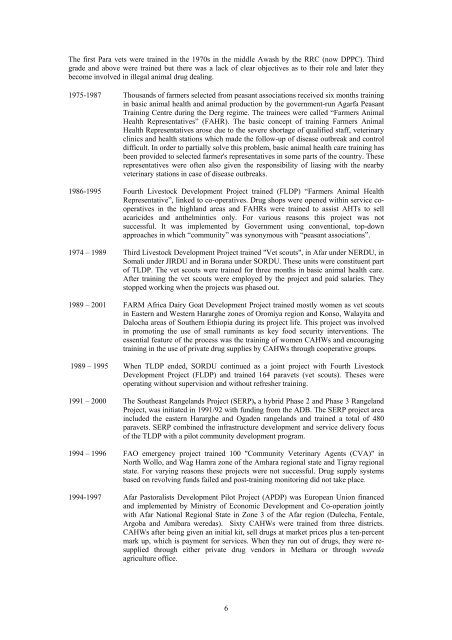Primary Animal Health Care in Ethiopia: The ... - Ethiopian Review
Primary Animal Health Care in Ethiopia: The ... - Ethiopian Review
Primary Animal Health Care in Ethiopia: The ... - Ethiopian Review
You also want an ePaper? Increase the reach of your titles
YUMPU automatically turns print PDFs into web optimized ePapers that Google loves.
<strong>The</strong> first Para vets were tra<strong>in</strong>ed <strong>in</strong> the 1970s <strong>in</strong> the middle Awash by the RRC (now DPPC). Thirdgrade and above were tra<strong>in</strong>ed but there was a lack of clear objectives as to their role and later theybecome <strong>in</strong>volved <strong>in</strong> illegal animal drug deal<strong>in</strong>g.1975-1987 Thousands of farmers selected from peasant associations received six months tra<strong>in</strong><strong>in</strong>g<strong>in</strong> basic animal health and animal production by the government-run Agarfa PeasantTra<strong>in</strong><strong>in</strong>g Centre dur<strong>in</strong>g the Derg regime. <strong>The</strong> tra<strong>in</strong>ees were called “Farmers <strong>Animal</strong><strong>Health</strong> Representatives” (FAHR). <strong>The</strong> basic concept of tra<strong>in</strong><strong>in</strong>g Farmers <strong>Animal</strong><strong>Health</strong> Representatives arose due to the severe shortage of qualified staff, veter<strong>in</strong>arycl<strong>in</strong>ics and health stations which made the follow-up of disease outbreak and controldifficult. In order to partially solve this problem, basic animal health care tra<strong>in</strong><strong>in</strong>g hasbeen provided to selected farmer's representatives <strong>in</strong> some parts of the country. <strong>The</strong>serepresentatives were often also given the responsibility of lias<strong>in</strong>g with the nearbyveter<strong>in</strong>ary stations <strong>in</strong> case of disease outbreaks.1986-1995 Fourth Livestock Development Project tra<strong>in</strong>ed (FLDP) “Farmers <strong>Animal</strong> <strong>Health</strong>Representative”, l<strong>in</strong>ked to co-operatives. Drug shops were opened with<strong>in</strong> service cooperatives<strong>in</strong> the highland areas and FAHRs were tra<strong>in</strong>ed to assist AHTs to sellacaricides and anthelm<strong>in</strong>tics only. For various reasons this project was notsuccessful. It was implemented by Government us<strong>in</strong>g conventional, top-downapproaches <strong>in</strong> which “community” was synonymous with “peasant associations”.1974 – 1989 Third Livestock Development Project tra<strong>in</strong>ed "Vet scouts", <strong>in</strong> Afar under NERDU, <strong>in</strong>Somali under JIRDU and <strong>in</strong> Borana under SORDU. <strong>The</strong>se units were constituent partof TLDP. <strong>The</strong> vet scouts were tra<strong>in</strong>ed for three months <strong>in</strong> basic animal health care.After tra<strong>in</strong><strong>in</strong>g the vet scouts were employed by the project and paid salaries. <strong>The</strong>ystopped work<strong>in</strong>g when the projects was phased out.1989 – 2001 FARM Africa Dairy Goat Development Project tra<strong>in</strong>ed mostly women as vet scouts<strong>in</strong> Eastern and Western Hararghe zones of Oromiya region and Konso, Walayita andDalocha areas of Southern <strong>Ethiopia</strong> dur<strong>in</strong>g its project life. This project was <strong>in</strong>volved<strong>in</strong> promot<strong>in</strong>g the use of small rum<strong>in</strong>ants as key food security <strong>in</strong>terventions. <strong>The</strong>essential feature of the process was the tra<strong>in</strong><strong>in</strong>g of women CAHWs and encourag<strong>in</strong>gtra<strong>in</strong><strong>in</strong>g <strong>in</strong> the use of private drug supplies by CAHWs through cooperative groups.1989 – 1995 When TLDP ended, SORDU cont<strong>in</strong>ued as a jo<strong>in</strong>t project with Fourth LivestockDevelopment Project (FLDP) and tra<strong>in</strong>ed 164 paravets (vet scouts). <strong>The</strong>ses wereoperat<strong>in</strong>g without supervision and without refresher tra<strong>in</strong><strong>in</strong>g.1991 – 2000 <strong>The</strong> Southeast Rangelands Project (SERP), a hybrid Phase 2 and Phase 3 RangelandProject, was <strong>in</strong>itiated <strong>in</strong> 1991/92 with fund<strong>in</strong>g from the ADB. <strong>The</strong> SERP project area<strong>in</strong>cluded the eastern Hararghe and Ogaden rangelands and tra<strong>in</strong>ed a total of 480paravets. SERP comb<strong>in</strong>ed the <strong>in</strong>frastructure development and service delivery focusof the TLDP with a pilot community development program.1994 – 1996 FAO emergency project tra<strong>in</strong>ed 100 "Community Veter<strong>in</strong>ary Agents (CVA)" <strong>in</strong>North Wollo, and Wag Hamra zone of the Amhara regional state and Tigray regionalstate. For vary<strong>in</strong>g reasons these projects were not successful. Drug supply systemsbased on revolv<strong>in</strong>g funds failed and post-tra<strong>in</strong><strong>in</strong>g monitor<strong>in</strong>g did not take place.1994-1997 Afar Pastoralists Development Pilot Project (APDP) was European Union f<strong>in</strong>ancedand implemented by M<strong>in</strong>istry of Economic Development and Co-operation jo<strong>in</strong>tlywith Afar National Regional State <strong>in</strong> Zone 3 of the Afar region (Dulecha, Fentale,Argoba and Amibara weredas). Sixty CAHWs were tra<strong>in</strong>ed from three districts.CAHWs after be<strong>in</strong>g given an <strong>in</strong>itial kit, sell drugs at market prices plus a ten-percentmark up, which is payment for services. When they run out of drugs, they were resuppliedthrough either private drug vendors <strong>in</strong> Methara or through weredaagriculture office.6




![to read the full report [pdf, Amharic] - Ethiopian Review](https://img.yumpu.com/52737829/1/190x245/to-read-the-full-report-pdf-amharic-ethiopian-review.jpg?quality=85)











